For a parasitologist, parasites in the human body are a standard field of work. Helminthic infestation is a terrible pathology for an ordinary patient. The situation is aggravated by a person's tendency to increase the scale of the problem without recognizing the enemy. Basic knowledge of the types of parasites that can live in the human body will help to overcome fear. Knowing the problem, you can already skillfully establish ways to deal with it or the principles of protection against it. In the following material, we will analyze which worms parasitize the human body.
Types of worms in the human body
It should be noted that not all real life worms in the human body can live. For many, the natural habitat is animal organisms, water or simply soil. The following is a list of the most common parasites in the human body with accompanying clinical manifestations.
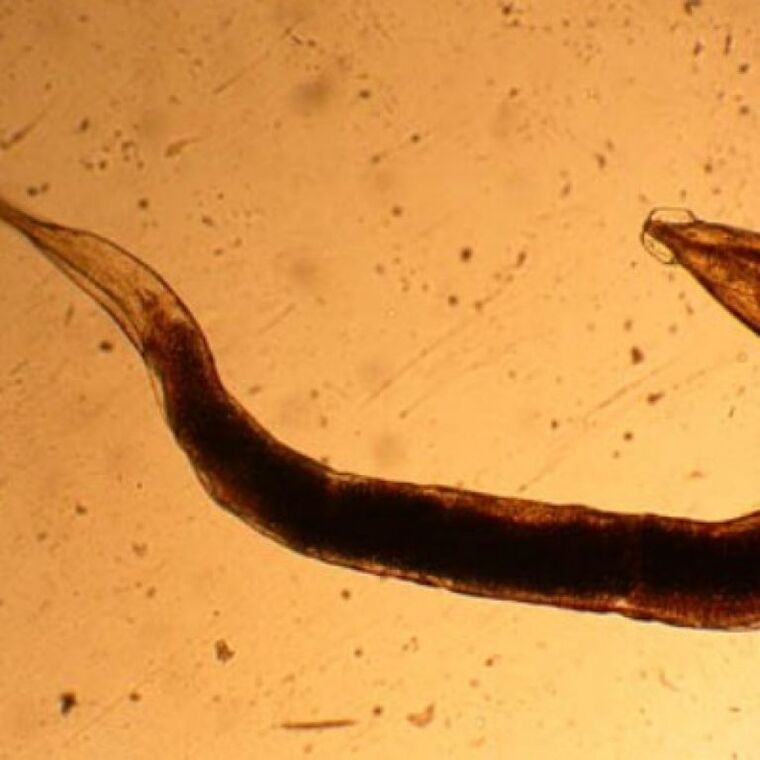
Pinworm
This is the most common parasite that enters the human body. In addition, human-like primates can also suffer from enterobiosis. Often pinworm is localized in the body of preschool children. Children between the ages of 1 and 10 are sick.
Pinworm infection occurs when a healthy person comes in contact with an infected person (shaking hands, dirty linens, towels, etc. ) in unwashed hands. In addition, pinworm eggs enter the human body through food.
Important: Insects (flies, cockroaches) also carry helminth eggs.
A mature woman crawls out of the anus at night and lays her eggs on the wrinkles of the skin of the anus, which causes severe itching. In addition, if the intensity of helminthic invasion is already high, the patient may have periodic pain in the lower abdomen. These are the symptoms of a parasitic infection that indicate the presence of pinworms in the body. These can be confused with general fatigue and allergic skin reactions.
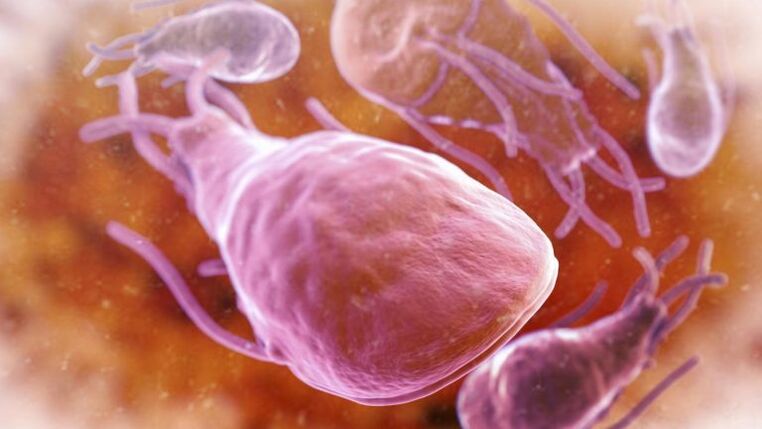
Giardia
Flagellate protozoa. In the human body, the localization of such parasites occurs mainly in the small intestine. However, through the bloodstream, protozoa can reach the liver and gallbladder. Parasites enter a person from dirty hands, unwashed vegetables / fruits, or by drinking dirty water.
Symptoms of Lamblia parasites:
- Pain in right hypochondria;
- Stool disorders;
- Excessive drilling;
- Nausea;
- neuroses;
- Allergic manifestations on the skin.
Ascaris
Roundworms are most common in people living in the small intestine. But at the same time, they can easily migrate to any organ through the bloodstream. It is often localized in the heart, lungs, liver and even the brain.
Infection with helminthic infections, vegetables, fruits, soil, etc. occurs through dirty hands where the parasite's eggs can remain. In this case, the symptoms of parasites vary depending on the stage of the disease. Thus, during larval migration, the following signs of parasites in the body are noted:
- Increased body temperature (38 degrees);
- Dry cough at night with shortness of breath;
- Swollen lymph nodes.
The following symptoms occur with the further location of worms in the human body:
- Fecal disorders (constipation and diarrhea);
- Nervous diseases;
- Pneumonia;
- Heart failure;
- Nausea;
- Vomiting;
- Frequent headaches;
- Stomach pain.
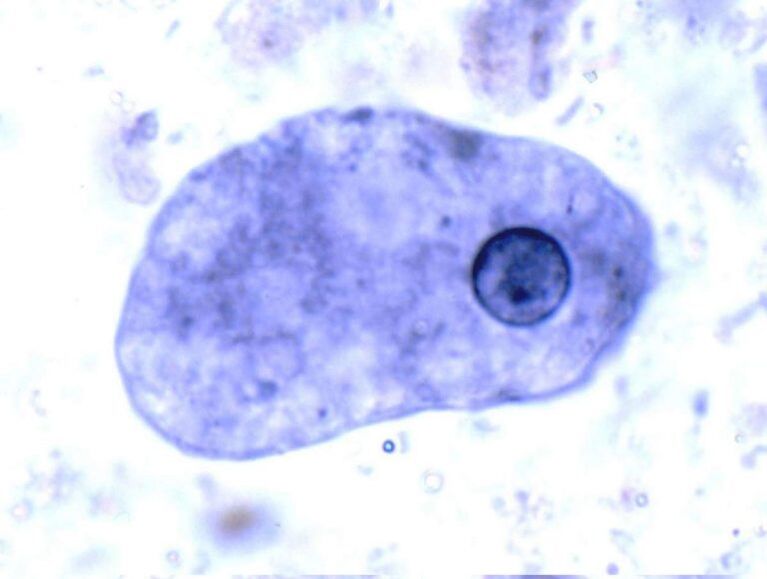
Amoeba histology
Amoeba is a protozoan parasite. It affects the human body through dirty hands, the use of dirty foods (vegetables, fruits, greens) and even anal. Flies can also have amoebiasis. The amoeba stimulates the formation of ulcers in the walls of the large intestine and further damage to other organs and systems. In this case, the symptoms of parasites in the body will be as follows:
- Feces with blood and mucus;
- Abdominal pain;
- Anemia;
- General weakness and fatigue;
- Formation of abscesses in organs where the parasite can be localized.
Toksokara
A round helminth that causes a helminthic infestation called toxocariasis. In this case, the parasite can be localized in the intestines, eyes and brain. Carriers of toxocara are dogs (dogs, worms, foxes, etc. ). Infection occurs either through contact with a sick animal or through indirect contact with feces. Infection with this type of parasite causes different symptoms depending on the organ where the worm larva is located. Thus, the symptoms of intestinal toxocariasis will be as follows:
- Nausea and vomiting;
- diarrhea and constipation;
- Abdominal pain.
A patient with ocular toxocariasis has the following signs of parasitic invasion:
- Decreased vision;
- Purulent discharge from the affected eye;
- Boiling on the eyelids;
- Redness of the sclera of the eye;
- Retinal detachment.
If the toxocara is located in the brain, the patient has the following signs of the presence of a parasite in the body:
- Headaches;
- Dizziness and fainting;
- Increased intracranial pressure;
- Nerves and hallucinations;
- Decreased vision and concentration.
In this case, the clinical picture is often confused with brain oncology.
- A patient with cardiac toxocariasis will experience heart failure such as tachycardia, arrhythmia, valve insufficiency, and heart pain.
- If the respiratory system is affected by toxocariasis, there are also symptoms of pneumonia or bronchitis, as well as frequent shortness of breath.
- If the worm is located under the skin, the patient will feel itching, movement, and redness on the skin will be noted where the helminth is.
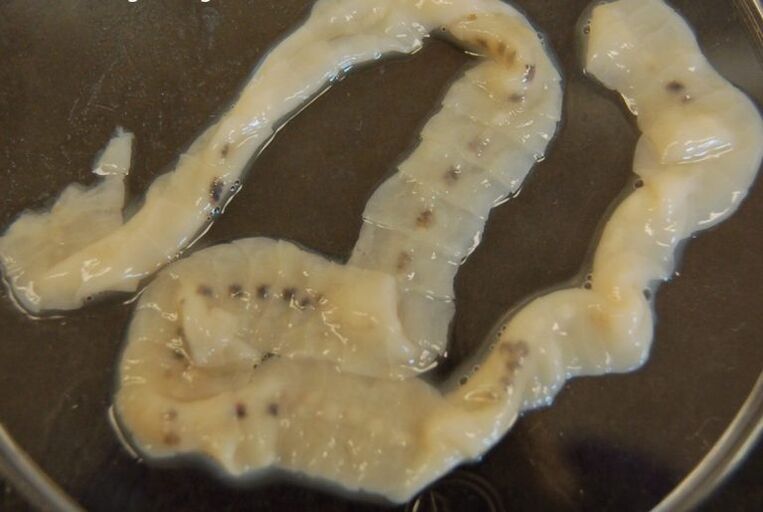
Wide Ribbon
This helminth lives in the small intestine of its biological owner. Passes through mouth with contaminated food (fish, fish caviar) or water. The symptoms of a worm in such a body are as follows:
- Abdominal pain;
- Nausea;
- Persistent anemia not corrected by iron supplementation;
- In an advanced stage of the pathology, intestinal obstruction occurs due to the accumulation of large amounts of parasites in the patient.
Pig tapeworm
This helminth lives in the bodies of animals (rabbits, pigs), as well as in the bodies of dogs and even camels. It enters the human body with contaminated meat that has undergone sufficient heat treatment. If an adult worm is found in the patient's body, the diagnosis is "teniasis. "If the worm is found in the larval stage, the diagnosis is "cysticercosis. "
Important: A patient with teniasis is dangerous both for himself (the reception of parasitic larvae in the brain, eyes, skeletal system) and for others.
The list of symptoms of the parasite in the human body looks like this:
- sharp decrease in appetite;
- Severe headaches;
- Abdominal pain;
- fainting;
- Decreased vision (with eye teniasis).
Important: The treatment of swine tapeworm is carried out only in a hospital under the supervision of specialists.
.jpg)
Beef tapeworm
A parasite that lives in a single individual in the human body. He arrives there with infected beef. The list of parasite symptoms in the human body looks like this:
- Invincible appetite and weight loss;
- Unstable chair;
- Abdominal pain;
- Severe allergic manifestations;
- Nausea.
Important: The parasite comes on its own when using certain anthelmintic drugs. In addition, the maximum length can be about 12 meters.
Necator and hookworm
These round parasites enter the human body either routinely from dirty hands and food, or from contact with the soil. The symptoms of the presence of such parasites in the human body look like this:
- Rash in the form of papules and vesicles on the body (purulent acne);
- Severe dry cough with shortness of breath;
- Abdominal pain;
- Persistent anemia;
- Diarrhea;
- Nausea;
- Critical anorexia.

Alveococcus
This parasite belongs to the cestode group. At the same time, it is important to know that helminths are extremely dangerous to humans, as they first form an initial source of inflammation in the liver and then spread to other organs. Human infection occurs through the ingestion of helminth oncospheres into the human mouth. This is often the case when cutting animal carcasses, hunting, using grass and berries collected in the forest and under-processed for food, and in direct contact with infected pets. In this case, only a specialist should assess the symptoms and treatment tactics. The clinical picture of helminthic invasion is as follows:
- Nausea and specific belching;
- Pain in right hypochondria;
- Allergy;
- Severe itching of the skin;
- The fullness of the area where the parasite is localized and the abscess explodes.
Important: The localization of such heat is often found in the lungs or brain. They just get rid of the parasite immediately.
Echinococcus
Canids and cats are carriers of echinococcus. In this situation, a person for the parasite is only an intermediate host. The danger of echinococcus to humans is that the helminth seriously affects a person's organs and systems and causes them to form cysts. People who work with animals and butchers are often infected with echinococcosis. That is, the parasite can enter the human body when cutting an animal's body, eating contaminated meat or water. Here it is important to know that the signs of the parasite's presence in an adult will not be visible for a long time. At the end of the asymptomatic phase, the following clinical picture appears:
- Violent hives;
- itchy skin;
- Pain at the site of the parasitic larva;
- Fever and fever (subject to washing of cysts).
Gnatostoma
These types of helminths enter the human body through contaminated poultry, fish or frog meat. You can also be infected with dirty water that contains worm larvae. The presence of such worms in the human body is manifested by the following symptoms:
- Severe dry cough;
- Pain in the area where the parasite larva is located;
- Severe swelling;
- Severe itching of the skin;
- Increased body temperature.
Important: After a week, all symptoms go away on their own, but reappear regularly over many years. A great danger is to damage the eyes and brain with worms. It can be fatal.
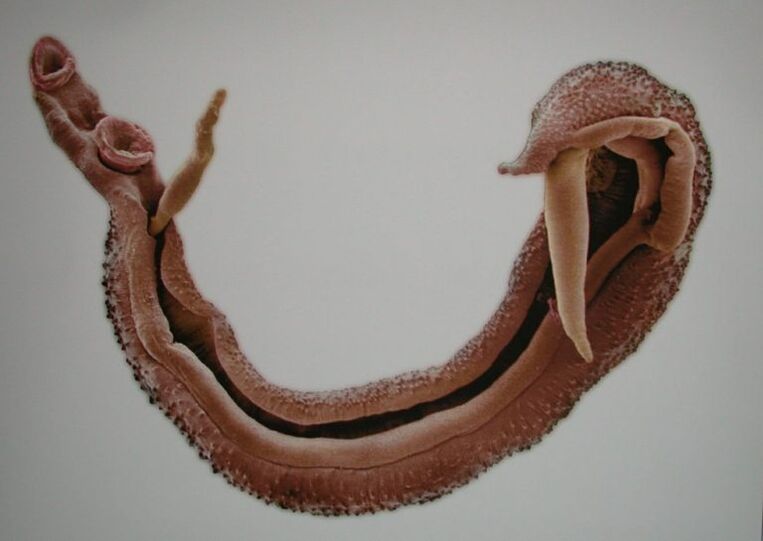
Schistosoma
Flux built. It is dangerous because it can penetrate the human body through the whole skin. Infection occurs in contaminated water (mostly in Africa), when washing clothes in contaminated water or irrigating the soil with it. The following are the first signs of the acute phase of the occupation:
- Extremely high body temperature (up to 39 degrees and above);
- Formation of papules in the body;
- Severe itching of the skin.
In the chronic stage, the disease manifests itself in prostatitis, colitis, colpitis, ascites, renal hydronephrosis, etc. shows in the form of symptoms. Urine analysis can detect schistosomiasis.
Trichinella
A round parasite that parasitizes the muscles of the human body in the larval stage and migrates to the small intestine when it matures. Trichinella is deadly to humans. You can be infected with such an invasion when you eat poorly fried / cooked meat of wild and domestic animals infected with worms. If the reader does not know how to determine the presence of such a parasite in the body, the clinical picture of the pathology looks like this:
- Vomiting and severe diarrhea;
- Abdominal pain;
- Anorexia;
- Muscle pain;
- Skin rashes;
- Swelling of the eyelids;
- The temperature rises to 40 degrees.
Important: Trichinosis is the only helminthic infestation in the human body treated with corticosteroid drugs.
After learning what parasites can live in the human body and how the infection occurs, as well as the symptoms of helminthic heat, you can insure yourself and your loved ones from infection. And if you suspect that you are infected with this or that type of parasite, seek specialized help in a timely manner.
























